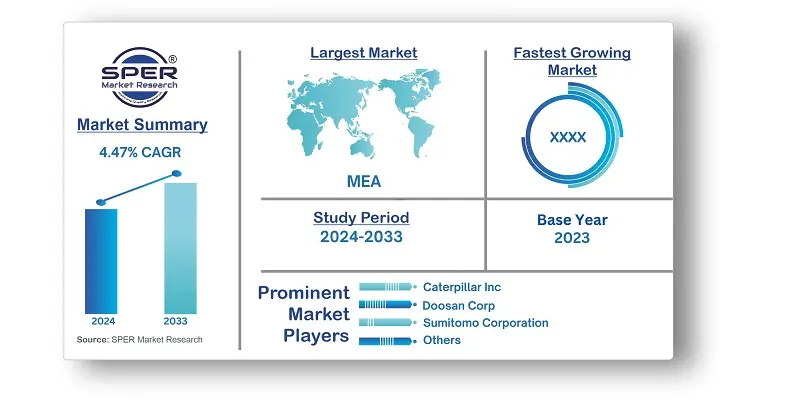
MEA Construction Equipment Market Growth, Size, Trends, Share, Demand and Future Outlook
Middle East and Africa Construction Equipment Market Size- By Machinery Type, By Drive Type- Regional Outlook, Competitive Strategies and Segment Forecast to 2033
| Published: Mar-2024 | Report ID: COAM2411 | Pages: 1 - 154 | Formats*: |
| Category : Construction & Manufacturing | |||
- SMT was appointed as Hitachi Construction Machinery's new African dealer in November 2022. In addition to servicing and selling Hitachi equipment in fifteen African nations, SMT will concentrate on supplying the profitable African mining industry with Hitachi Zaxis and EX series excavators.
- August 2022: Expertise Contracting Company in Saudi Arabia received an order for 82 cranes from Tadano Demag GmbH.


| Report Metric | Details |
| Market size available for years | 2020-2033 |
| Base year considered | 2023 |
| Forecast period | 2024-2033 |
| Segments covered | By Airbag Type, By Inflator Type, By Vehicle Type |
| Regions covered | By Machinery Type, By Drive Type |
| Companies Covered | Caterpillar Inc., CNH Industrial (Case Construction), Doosan Corp, Hitachi Construction Machinery Co., JCB, Kobelco Construction Machinery Co. Ltd, Liebherr Group, Manitowoc Company Inc., Sumitomo Corporation, Mitsubishi Electric Corporation, Volvo AB, Others |
- Construction Companies
- Infrastructure Developers
- Governments and Municipalities
- Rental Companies
- Equipment Manufacturers and Suppliers
| By Machinery Type: |
|
| By Drive Type: |
|
| By Region: |
|
- Middle East and Africa Construction Equipment Market Size (FY’2024-FY’2033)
- Overview of Middle East and Africa Construction Equipment Market
- Segmentation of Middle East and Africa Construction Equipment Market By Machinery Type (Crane, Telescopic Handling, Excavator, Loaders, Motor Graders, Others)
- Segmentation of Middle East and Africa Construction Equipment Market By Drive Type (Electric and Hybrid, Hydraulic)
- Expansion Analysis of Middle East and Africa Construction Equipment Market
- Problems and Obstacles in Middle East and Africa Construction Equipment Market
- Competitive Landscape in the Middle East and Africa Construction Equipment Market
- Impact of COVID-19 and Demonetization on Middle East and Africa Construction Equipment Market
- Details on Current Investment in Middle East and Africa Construction Equipment Market
- Competitive Analysis of Middle East and Africa Construction Equipment Market
- Prominent Players in the Middle East and Africa Construction Equipment Market
- SWOT Analysis of Middle East and Africa Construction Equipment Market
- Middle East and Africa Construction Equipment Market Future Outlook and Projections (FY’2024-FY’2033)
- Recommendations from Analyst
1.1. Scope of the report1.2. Market segment analysis
2.1. Research data source2.1.1. Secondary Data2.1.2. Primary Data2.1.3. SPER’s internal database2.1.4. Premium insight from KOL’s2.2. Market size estimation2.2.1. Top-down and Bottom-up approach2.3. Data triangulation
4.1. Driver, Restraint, Opportunity and Challenges analysis
4.1.1. Drivers4.1.2. Restraints4.1.3. Opportunities4.1.4. Challenges4.2. COVID-19 Impacts of the Middle East and Africa Construction Equipment Market
5.1. SWOT Analysis5.1.1. Strengths5.1.2. Weaknesses5.1.3. Opportunities5.1.4. Threats5.2. PESTEL Analysis5.2.1. Political Landscape5.2.2. Economic Landscape5.2.3. Social Landscape5.2.4. Technological Landscape5.2.5. Environmental Landscape5.2.6. Legal Landscape5.3. PORTER’s Five Forces5.3.1. Bargaining power of suppliers5.3.2. Bargaining power of buyers5.3.3. Threat of Substitute5.3.4. Threat of new entrant5.3.5. Competitive rivalry5.4. Heat Map Analysis
6.1. Middle East and Africa Construction Equipment Market Manufacturing Base Distribution, Sales Area, Product Type6.2. Mergers & Acquisitions, Partnerships, Product Launch, and Collaboration in Middle East and Africa Construction Equipment Market
7.1. Middle East and Africa Construction Equipment Market Value Share and Forecast, By Machinery Type, 2024-20337.2. Crane7.3. Telescopic Handling7.4. Excavator7.5. Loaders7.6. Motor Graders7.7. Others
8.1. Middle East and Africa Construction Equipment Market Value Share and Forecast, By Drive Type, 2024-20338.2. Electric and Hybrid8.3. Hydraulic
9.1. Middle East and Africa Construction Equipment Market Size and Market Share
10.1. Middle East and Africa Construction Equipment Market Size and Market Share By Machinery Type (2020-2026)10.2. Middle East and Africa Construction Equipment Market Size and Market Share By Machinery Type (2027-2033)
11.1. Middle East and Africa Construction Equipment Market Size and Market Share By Drive Type (2020-2026)11.2. Middle East and Africa Construction Equipment Market Size and Market Share By Drive Type (2027-2033)
12.1. Middle East and Africa Construction Equipment Market Size and Market Share By Region (2020-2026)12.2. Middle East and Africa Construction Equipment Market Size and Market Share By Region (2027-2033)12.3. Saudi Arabia12.4. South Africa12.5. United Arab Emirates12.6. Qatar12.7. Morocco12.8. Rest of Middle East and Africa
13.1. Caterpillar Inc.13.1.1. Company details13.1.2. Financial outlook13.1.3. Product summary13.1.4. Recent developments13.2. CNH Industrial (Case Construction)13.2.1. Company details13.2.2. Financial outlook13.2.3. Product summary13.2.4. Recent developments13.3. Doosan Corp13.3.1. Company details13.3.2. Financial outlook13.3.3. Product summary13.3.4. Recent developments13.4. Hitachi Construction Machinery Co.13.4.1. Company details13.4.2. Financial outlook13.4.3. Product summary13.4.4. Recent developments13.5. JCB13.5.1. Company details13.5.2. Financial outlook13.5.3. Product summary13.5.4. Recent developments13.6. Kobelco Construction Machinery Co. Ltd13.6.1. Company details13.6.2. Financial outlook13.6.3. Product summary13.6.4. Recent developments13.7. Liebherr Group13.7.1. Company details13.7.2. Financial outlook13.7.3. Product summary13.7.4. Recent developments13.8. Manitowoc Company Inc.13.8.1. Company details13.8.2. Financial outlook13.8.3. Product summary13.8.4. Recent developments13.9. Sumitomo Corporation13.9.1. Company details13.9.2. Financial outlook13.9.3. Product summary13.9.4. Recent developments13.10. Mitsubishi Electric Corporation13.10.1. Company details13.10.2. Financial outlook13.10.3. Product summary13.10.4. Recent developments13.11. Volvo AB13.11.1. Company details13.11.2. Financial outlook13.11.3. Product summary13.11.4. Recent developments13.12. Others
SPER Market Research’s methodology uses great emphasis on primary research to ensure that the market intelligence insights are up to date, reliable and accurate. Primary interviews are done with players involved in each phase of a supply chain to analyze the market forecasting. The secondary research method is used to help you fully understand how the future markets and the spending patterns look likes.
The report is based on in-depth qualitative and quantitative analysis of the Product Market. The quantitative analysis involves the application of various projection and sampling techniques. The qualitative analysis involves primary interviews, surveys, and vendor briefings. The data gathered as a result of these processes are validated through experts opinion. Our research methodology entails an ideal mixture of primary and secondary initiatives.



Frequently Asked Questions About This Report
PLACE AN ORDER
Year End Discount
Sample Report
Pre-Purchase Inquiry
NEED CUSTOMIZATION?
Request CustomizationCALL OR EMAIL US
100% Secure Payment






Related Reports
Our Global Clients
Our data-driven insights have influenced the strategy of 200+ reputed companies across the globe.




















